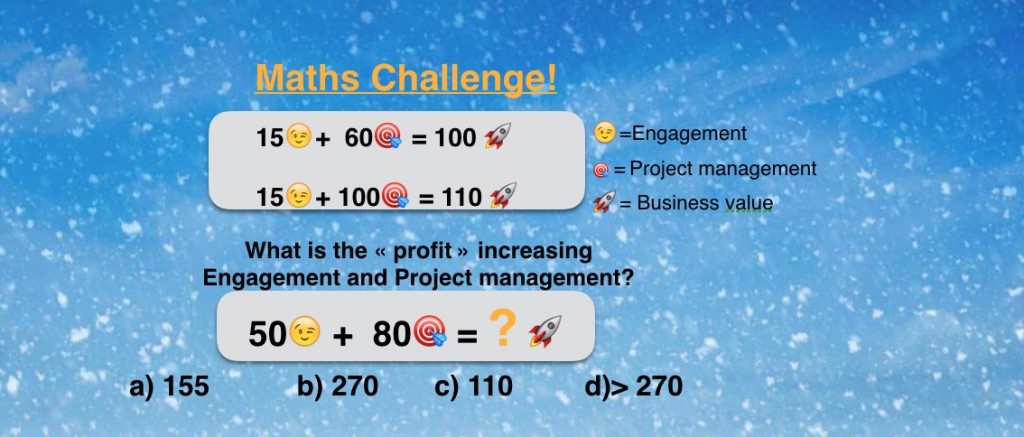Statistics on business transformation, projects and engagement
Since we all, either executive, financial, HR leader or project leader have the same objective to bring more value to the business, let’s look at the following statistics:
[/vc_column_text]
Business transformations success rate:
- MacKinsey&Company, 2015: “26% of executive respondents say the transformations have been successful at both improving performance and equipping the organization to sustain improvements over the time”
- Project Management Institute Pulse of the profession, 2016: “only 62% of projects meet their original goals and business intent”, (64% in 2012); the trend of projects performance metrics goes slightly down compared to 2012.
Project success rates:
- PMO Pulse of the profession, 2015 : 64% of projects are successful however, high performing organizations experience 2,5 times more successful projects. More than half of projects are over budget, a third fail to achieve business objectives, and:
- 17% fail outright.
- various Gartner sudies on IT projects, like AAA-Rated Project Failures — Abdication, Avoidance and Apathy and other sources like Gartner et Wrike show that the bigger the project is the higher is the chance to fail with a threshold of 350 000 USD for IT projects.
Employee engagement:
- Gallup : worldwide (study across 142 countries) , only 13% of Employees are engaged at work, meaning “emotionally invested in and focused on creating value for their organizations every day”
Engaged employees (13%) work with passion and feel a profound connection to their company. They drive innovation and move the organization forward.
Not Engaged employees (63%) are essentially “checked out.” They’re sleepwalking through their workday, putting time — but not energy or passion —into their work.
Actively Disengaged employees (24%) aren’t just unhappy at work; they’rebusy acting out their unhappiness. Every day, these workers undermine what their engaged coworkers accomplish.
Financial impact:
PMI Pulse of the profession, 2014: “poor performance results in organizations losing 109 million US dollars for every 1 billion invested; meaning 11 cents for every dollar. In PMI Pulse of the profession 2016, the situation is even worst: 122 million US dollars wasted for every 1 billion invested due to poor project performance, a 12% increase over 2015.
Gallup: estimates that for the US, active disengagement costs US$450 billion to $550 billion, for Germany between €112 billion and € 138 billion, for the UK between £52 and £70 billion.
How changing these statistics?
McKinsey based on success stories recommends a set of 24 actions about communicating effectively, leading actively, empowering employees, and creating an environment of continuous improvement, including a dedicated organizing team (e.g..project management or transformation office).
PMI outlines the need of a culture change with “formal project and program management in their change the business initiatives”, to be them aligned to the organization strategy.
Gallup outlines the importante of the soft skills in management roles and also the correlation with performance : when organizations successfully engage their customers and their employees, they experience a 240% boost un performance related outcomes. In other words, linking individual contribution to meaningful purpose.
As a conclusion, beyond these statistics, we can conclude :
- There is no magic recipe, it is good to look at best practice, but the main part still needs to be invented, co-created with each company, each team.
- What is sure, only the combination of intrinsic and collective leadership with hard skills can lead to success. That’s where transforming projects into a team adventure and entrepreneurship spirit in corporations are great ways to increase chance to succeed.

NB : solution to the maths challenge:
From pure mathematical perspective, the correct answer is b) 270, however nobody knows how much extra value we could reach by increasing engagement and professional project management, this is most likely above 270, so the correct answer si d) > 270

